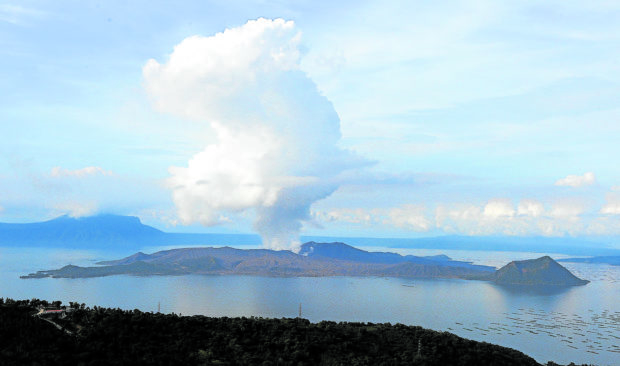
STEAM-DRIVEN SMOKE Taal Volcano emits steam-driven plumes as seen from Tagaytay-
Talisay Road, Tagaytay City, Cavite provice, on Monday morning. INQUIRER file photo / NIÑO JESUS ORBETA
MANILA, Philippines — Volcanic smog, or vog, persisted over Taal Volcano as it continued to emit high levels of sulfur dioxide, the Philippine Institute of Volcanology and Seismology (Phivolcs) said Tuesday.
In its 24-hour monitoring bulletin, Phivolcs said the sulfur dioxide emission averaged 8,577-metric ton per day.
It also emitted plumes 3,000 meters tall in the air that drifted southwest, as hot volcanic fluid continued to rise in the volcano’s main crater.
Volcanic smog also continued to persist over Taal Volcano and in the surrounding areas.
Aside from these, the Phivolcs recorded 42 volcanic earthquakes, including six volcanic tremor events having durations of two minutes, and 36 low-frequency volcanic earthquakes.
Additionally, low-level background tremors have been ongoing since July 7.
Phivolcs said the Taal Volcano Island has begun deflating in April 2021, while the Taal region continues to undergo very slow extension since 2020.
Alert Level 2 remains over the volcano, meaning sudden steam- or gas-driven explosions, volcanic earthquakes, minor ashfall, and lethal accumulations or expulsions of volcanic gas can occur.
Entry into Taal’s Permanent Danger Zone remains strictly prohibited, especially in the vicinities of the main crater and the Daang Kastila fissure. This applies to occupancy and boating on Taal Lake, Phivolcs said.
Phivolcs likewise advised local government officials to continuously assess and strengthen the preparedness of previously evacuated barangays around Taal Lake in case of renewed unrest.
Given the hazards of airborne ash and ballistic fragments from sudden explosions and wind-remobilized ash, civil aviation authorities must advise pilots to avoid flying close to the volcano, the agency added. McKenzie Kinsella, INQUIRER.net trainee